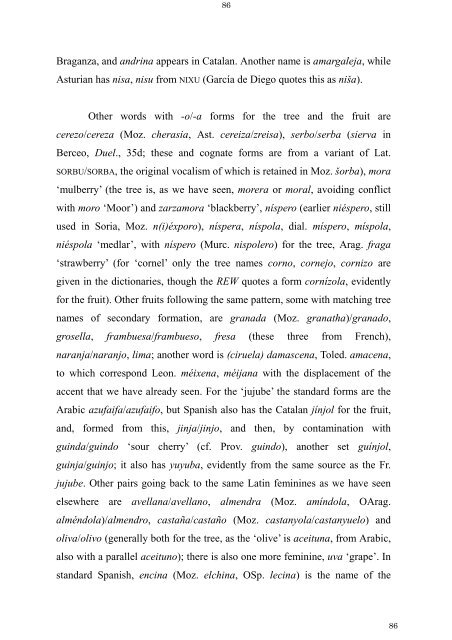The Latin Neuter Plurals in Romance - Page ON
The Latin Neuter Plurals in Romance - Page ON
The Latin Neuter Plurals in Romance - Page ON
Create successful ePaper yourself
Turn your PDF publications into a flip-book with our unique Google optimized e-Paper software.
86<br />
Braganza, and andr<strong>in</strong>a appears <strong>in</strong> Catalan. Another name is amargaleja, while<br />
Asturian has nisa, nisu from NIXU (García de Diego quotes this as niša).<br />
Other words with -o/-a forms for the tree and the fruit are<br />
cerezo/cereza (Moz. cherasia, Ast. cereiza/zreisa), serbo/serba (sierva <strong>in</strong><br />
Berceo, Duel., 35d; these and cognate forms are from a variant of Lat.<br />
SORBU/SORBA, the orig<strong>in</strong>al vocalism of which is reta<strong>in</strong>ed <strong>in</strong> Moz. šorba), mora<br />
‘mulberry’ (the tree is, as we have seen, morera or moral, avoid<strong>in</strong>g conflict<br />
with moro ‘Moor’) and zarzamora ‘blackberry’, níspero (earlier niéspero, still<br />
used <strong>in</strong> Soria, Moz. n(i)éxporo), níspera, níspola, dial. míspero, míspola,<br />
niéspola ‘medlar’, with níspero (Murc. nispolero) for the tree, Arag. fraga<br />
‘strawberry’ (for ‘cornel’ only the tree names corno, cornejo, cornizo are<br />
given <strong>in</strong> the dictionaries, though the REW quotes a form cornízola, evidently<br />
for the fruit). Other fruits follow<strong>in</strong>g the same pattern, some with match<strong>in</strong>g tree<br />
names of secondary formation, are granada (Moz. granatha)/granado,<br />
grosella, frambuesa/frambueso, fresa (these three from French),<br />
naranja/naranjo, lima; another word is (ciruela) damascena, Toled. amacena,<br />
to which correspond Leon. méixena, méijana with the displacement of the<br />
accent that we have already seen. For the ‘jujube’ the standard forms are the<br />
Arabic azufaifa/azufaifo, but Spanish also has the Catalan jínjol for the fruit,<br />
and, formed from this, j<strong>in</strong>ja/j<strong>in</strong>jo, and then, by contam<strong>in</strong>ation with<br />
gu<strong>in</strong>da/gu<strong>in</strong>do ‘sour cherry’ (cf. Prov. gu<strong>in</strong>do), another set guínjol,<br />
gu<strong>in</strong>ja/gu<strong>in</strong>jo; it also has yuyuba, evidently from the same source as the Fr.<br />
jujube. Other pairs go<strong>in</strong>g back to the same <strong>Lat<strong>in</strong></strong> fem<strong>in</strong><strong>in</strong>es as we have seen<br />
elsewhere are avellana/avellano, almendra (Moz. amíndola, OArag.<br />
alméndola)/almendro, castaña/castaño (Moz. castanyola/castanyuelo) and<br />
oliva/olivo (generally both for the tree, as the ‘olive’ is aceituna, from Arabic,<br />
also with a parallel aceituno); there is also one more fem<strong>in</strong><strong>in</strong>e, uva ‘grape’. In<br />
standard Spanish, enc<strong>in</strong>a (Moz. elch<strong>in</strong>a, OSp. lec<strong>in</strong>a) is the name of the<br />
86









